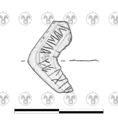NO-19
| Inscription | |
|---|---|
| Transliteration: | ?§velθiẹ |
| Original script: | |
|
| |
| Object: | NO-19 plaque (bronze) |
| Position: | |
| Script: | North Italic script (Sanzeno alphabet) |
| Direction of writing: | sinistroverse |
| Letter height: | 0.5 cm |
| Number of letters: | 6 |
| Number of lines: | 1 |
| Craftsmanship: | engraved |
| Current condition: | damaged |
| Date of inscription: | |
| Date derived from: | |
|
| |
| Language: | Raetic |
| Meaning: | 'Velθie' (PN) (?) |
|
| |
| Alternative sigla: | none |
Images
|
Object NO-19 plaque with inscription NO-19.
|
Object NO-19 plaque with inscription NO-19.
|
Commentary
Unpublished. Autopsied by TIR in October 2014.
The inscription or remains of it consists of two parts, one legible, the other illegible. The legible part is inscribed between the elliptical chased ornament in the bend of the fragment, and its narrower end (1.7 cm). ![]()
![]()
![]()
![]() are well legible, the following hasta is probably
are well legible, the following hasta is probably ![]() . The main problem concerning this inscription is the question of when it was applied. It seems clear that the object was part of a votive figure cut out of bronze sheet, most probably an arm (see NO-19 plaque). Seeing as it is assumed that old metal was reused for this purpose, it cannot be quite excluded that the inscription was part of the original object. In this case, it might be fragmented. It does not, however, seem likely that an inscribed object would be destroyed in that way, or either, that a strange inscription would not have been considered objectionable on a votive. Also, the inscription follows the curve neatly. It is therefore likely to belong to the little votive arm, which has a quite appropriate length; the inscription can hardly have been longer. The last letter is definitely incomplete, but this may be due to the damage sustained by the rims of the thin sheet. The preserved parts are a hasta and two bars, the upper one very close to the upper edge. The options are
. The main problem concerning this inscription is the question of when it was applied. It seems clear that the object was part of a votive figure cut out of bronze sheet, most probably an arm (see NO-19 plaque). Seeing as it is assumed that old metal was reused for this purpose, it cannot be quite excluded that the inscription was part of the original object. In this case, it might be fragmented. It does not, however, seem likely that an inscribed object would be destroyed in that way, or either, that a strange inscription would not have been considered objectionable on a votive. Also, the inscription follows the curve neatly. It is therefore likely to belong to the little votive arm, which has a quite appropriate length; the inscription can hardly have been longer. The last letter is definitely incomplete, but this may be due to the damage sustained by the rims of the thin sheet. The preserved parts are a hasta and two bars, the upper one very close to the upper edge. The options are ![]() and
and ![]() with the third bar above the preserved ones; in light of the above considerations concerning the inscription's original length, we prefer e as the typical auslaut of Raetic individual names.
with the third bar above the preserved ones; in light of the above considerations concerning the inscription's original length, we prefer e as the typical auslaut of Raetic individual names.
The other part of the inscription appears to be complete as well, extending between the ornament and a chased line extending toward it from the breaking edge (1.8 cm). The lines are well distinguishable, but cannot be arranged into letters (apart from maybe ![]() and
and ![]() on the left); the effect is also near-symmetrical. A pseudo-script line filler?
on the left); the effect is also near-symmetrical. A pseudo-script line filler?

